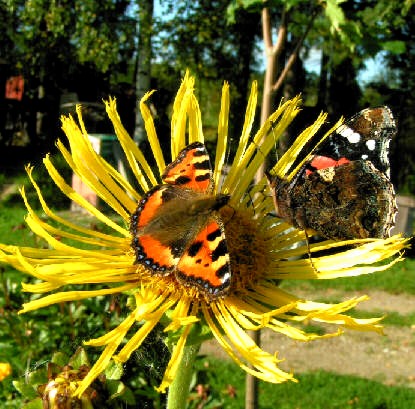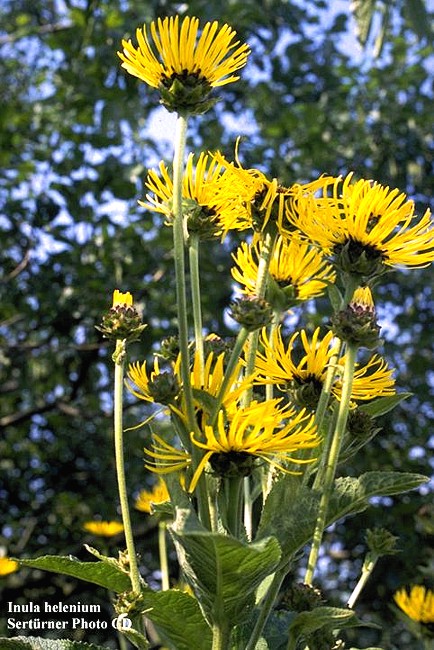Lessico
Enula
Inula helenium

Il termine
scientifico Inula helenium è composto da due vocaboli che hanno la
stessa origine. Infatti si suppone che inula sia un prestito del latino
popolare dal greco helénion con metatesi - trasposizione - delle
consonanti l-n in n-l, come accade per esempio nell'italiano padule
equivalente a palude. Non fatevi intrappolare da padulo, l'uccello che vola
dritto al culo, in quanto si tratta di una riesumazione a fini burleschi di un
antico padulo equivalente a padule. Anche helenium deriva, ma in modo
esplicito, dal greco helénion che significa enula in Dioscoride I,29 e
che si ammette derivi da Helénë, Elena![]() ,
moglie di Menelao
,
moglie di Menelao![]() e sorella dei Dioscuri
e sorella dei Dioscuri![]() .
.
Ma la
confusione non è ancora finita. Esiste in questo capitolo di Dioscoride![]() anche un helénion
egiziano - Alterum Helenii genus in Aegypto gigni Cratevas
anche un helénion
egiziano - Alterum Helenii genus in Aegypto gigni Cratevas![]() tradit
- che è strisciante come il
timo serpillo
tradit
- che è strisciante come il
timo serpillo![]() ,
e secondo Plinio questa pianta egiziana, non la nostra enula, prese il nome da
Elena in quanto nacque dalle sue lacrime quando approdò - Pausania
,
e secondo Plinio questa pianta egiziana, non la nostra enula, prese il nome da
Elena in quanto nacque dalle sue lacrime quando approdò - Pausania![]() dice dopo
la caduta di Troia - su un'isola del mare Egeo: Helenium e lacrimis Helenae
dicitur natum, et ideo in Helene insula laudatissimum (XXI,59).
dice dopo
la caduta di Troia - su un'isola del mare Egeo: Helenium e lacrimis Helenae
dicitur natum, et ideo in Helene insula laudatissimum (XXI,59).
Quest'isola posta a est dell'apice meridionale dell'Attica ricevette il nome di Elena ma era anche detta Mákris in quanto lunga e stretta: L'aggettivo greco makrós sì che significa vasto, grande, ma in prima istanza significa esteso, lungo, espresso in latino da macer = magro, scarno, esile. Oggi infatti quest'isola si chiama Makrónisos, Μακρόνησος in greco, cioè, isola lunga, come lo è Long Island su cui giace buona parte di New York. Solo che Long Island è lunga 190 km e larga circa 36, mentre Makrónisos si allunga per soli 11,2 km e il suo punto più largo raggiunge 2,6 km.
Invece per la nostra enula - Inula helenium -la mitologia tira pur sempre in ballo Elena ma ammette che la stringeva in mano quando venne rapita da Paride per essere trasbordata a Troia. Di seguito troverete in altre fonti altre interpretazioni sia per inula che per helenium.
Inula
helenium: pianta della famiglia
Composite o Asteracee. È un'erbacea perenne dei luoghi erbosi umidi
dell'Europa, Asia temperata e America Settentrionale; ha radice carnosa,
aromatica, amara e fusto grosso, alto fino a circa 1 m, villoso, ramificato e
corimbo; le foglie sono ampie; oblunghe, dentate, scabre superiormente e
tomentose sulla pagina inferiore, le inferiori picciolate e le superiori
sessili. I capolini sono giallo-dorati; i frutti sono acheni glabri, privi di
pappo. Se ne usa la radice, dotata di proprietà eupeptica, coleretica,
balsamica, antispasmodica e diuretica e rappresenta una delle fonti più notevoli
di inulina![]() ,
assai importante in medicina.
,
assai importante in medicina.


Inula
helenium
Enula campana - Viola campana - Ella -
Lelia

Descrizione - Pianta perenne della famiglia Composite con grosso rizoma carnoso ramificato e con fusto molto robusto alto fino a 150-200 cm, nella parte inferiore ricoperto di peli ispidi, mentre superiormente è solo pubescente. Le foglie basali grandissime , lunghe anche 70 cm, portano un lungo picciolo, apice acuto e la superficie coperta di peli. Le foglie del caule sono alterne, spesse, tomentose disotto, mentre quelle superiori sono sessili e cordato-amplessicauli. I fiori sono riuniti in grossi capolini di 6-7 cm. di diametro, che formano una infiorescenza corimbosa rada. I capolini hanno un involucro con una serie di brattee quasi simili a piccole foglie, con fiori giallo-dorati e ligule raggianti molto lunghe. L'impollinazione avviene tramite farfalle e api. Il frutto è un achenio cilindrico con pappo di peli lunghi.
Antesi - luglio-settembre
Tipo corologico - Europa Sud Orientale e Asia Occidentale
Distribuzione - È diffusa nella pianura padana, nell’Italia centrale, mentre è rara al Sud e nelle isole.
Habitat - In vicinanza dei fossati, siepi, in prati umidi fino a 800 mt. Veniva coltivata per scopi medicinali; sfuggita alle coltivazioni, la si trova un po’ ovunque.
Etimologia – Inula deriva dal greco inéein o ináein che significa svuotare, evacuare, purgare, per le proprietà medicinali contenute nelle radici di varie specie di questo gruppo. Mentre il nome della specie helenium pare derivi dal greco Elena, che secondo la leggenda stringeva l’enula in mano quando partì alla volta di Troia.
Utilizzi e Curiosità - Dall’antichità a oggi le virtù dell’Enula campana e la sua fama non si sono affievolite. La sua radice è la parte più attiva. Infatti il suo rizoma essiccato, si usa per via orale per la ricchezza di un particolare olio volatile, l’enulina, principio attivo, che esercita una utilissima attività fluidificante,soprattutto nel trattamento dei disturbi dell’apparato respiratorio. Calma la tosse disinfettando l’albero respiratorio, risolvendo le bronchiti da raffreddamento. Altro principio attivo è l’alantolattone, che si ritiene antifiammatorio e stimolante del sistema immunitario. Per uso esterno è un rimedio contro i pruriti conseguenti a eczema ed eruzioni cutanee in genere. Celebre è anche il vino d’Enula, come aperitivo e pettorale, che si ottiene aggiungendo una percentuale di radice essiccata nel vino. Una volta si impiegava sia per tingere gli abiti di cotone o di lino di blue, sia come mordente nelle tinture con l’aggiunta di more di rovo. Oggi per la varietà a grandi fiori viene usata anche nei giardini per creare ampie macchie di colore.
www.funghiitaliani.it

Elecampane, also called Horse-heal (Inula helenium) or Marchalan (in Welsh), is a perennial composite plant common in many parts of Great Britain, and ranges throughout central and Southern Europe, and in Asia as far eastwards as the Himalayas. It is a rather rigid herb, the stem of which attains a height of from 3 to 5 feet; the leaves are large and toothed, the lower ones stalked, the rest embracing the stem; the flowers are yellow, 2 inches broad, and have many rays, each three-notched at the extremity. The root is thick, branching and mucilaginous, and has a warm, bitter taste and a camphoraceous odor. The plant's specific name, helenium, derives from Helen of Troy; elecampane is said to have sprung up from where her tears fell. It was sacred to the ancient Celts, and once had the name "elfwort".
For medicinal purposes it should be procured from plants not more than two or three years old. Besides inulin, C6H12O6(C6H10O5)n, a body isomeric with starch, the root contains helenin, C15H20O2, a stearoptene, which may be prepared in white acicular crystals, insoluble in water, but freely soluble in alcohol. When freed from the accompanying inula-camphor by repeated crystallization from alcohol, helenin melts at 110 °C. By the ancients the root was employed both as a medicine and as a condiment, and in England it was formerly in great repute as an aromatic tonic and stimulant of the secretory organs. As a drug, however, the root is now seldom resorted to except in veterinary practice, though it is undoubtedly possessed of antiseptic properties. In France and Switzerland it is used in the manufacture of absinthe.
Susan O'Shea, a research student at Cork Institute of Technology (CIT), Ireland, has shown that extracts from the herb kill methicillin-resistant Staphylococcus aureus as well as a broad spectrum of other bacteria. John Gerard recommended elecampane for "the shortness of breath"; today herbalists prescribe it as an expectorant and for water retention; it also is claimed to have antiseptic properties. It has minor applications as a tonic and to bring on menstruation.
La grande aunée ou inule aunée (Inula helenium) est une grande plante d'origine asiatique, naturalisée depuis longtemps en Europe, où on l'a utilisée pour ses vertus médicinales. Elle appartient au genre Inula et à la famille des Asteraceae (Composées: plantes dans lesquelles ce qu'on appelle couramment fleur est en fait un capitule formé de nombreux fleurons entourés d'un involucre de bractées). Dans cette vaste famille, les inules se rapprochent des marguerites, avec deux types de fleurons: à la périphérie des fleurons ligulés, au centre (disque), des fleurons tubulés. Les fleurons périphériques du genre Inula sont femelles, tandis que les fleurons du disque sont hermaphrodites. Son nom scientifique, Inula helenium, vient du fait qu'Hélène aurait eu une branche d'aunée dans la main lorsqu'elle fut enlevée par Pâris.
Plante vivace plus ou moins velue, formant parfois des touffes importantes. Tiges érigées pouvant facilement atteindre deux mètres. Grandes feuilles simples ovales, alternes, régulièrement et finement dentées, les inférieures pétiolées, les supérieures sessiles et engainantes. L'inflorescence est un corymbe de capitules jaunes assez grands (généralement plus de 4 cm), mais certains capitules peuvent aussi être solitaires. Les bractées extérieures de l'involucre, ovales à extrémité pointue, ont tendance à se recourber. Les fleurons périphériques se présentent sous la forme de longues et fines languettes. Les fruits sont des akènes bruns. Floraison en été.
Type d'inflorescence:
corymbe de capitules
Répartition des sexes: hermaphrodite
Type de pollinisation: entomogame, autogame
Période de floraison: juillet-août
Type de fruit: akène
Mode de dissémination: anémochore
Habitat type: mégaphorbiaies planitiaires-collinéennes, eutrophiles
Aire de répartition: introduit (Asie occ.)
La grande aunée fait partie des plantes comestibles. On apprécie en particulier sa racine très aromatique, utilisée fraîche ou séchée pour parfumer certains desserts. Cette racine, à la fois amère et tonique (d'où le nom de quinquina français parfois donné à la plante), possède également diverses vertus médicinales: elle est notamment recommandée pour son action sur les bronches.
Autrefois, cette plante n'était pas seulement réputée pour ses propriétés médicinales: la légende raconte que la belle Hélène en tenait une branche à la main lorsqu'elle fut enlevée par Pâris (d'où son nom scientifique). Dans la symbolique chrétienne, elle est associée, en raison de ses pouvoirs médicinaux, à la guérison des péchés. « L'Inula résiste au poison, éclaire la poitrine malade / Et donne au coeur joie et plaisir. Celui qui aime la parole de Dieu et son église, / qu'il traverse sans peine la vallée des soupirs de la vie... » (Hohberg, 1675)
L'inulina è un polimero glucidico con peso molecolare minore dell'amido, solubile in acqua e totalmente accumulato nei vacuoli. Si ottiene dalla polimerizzazione del ß-D-fruttosio. Per azione dell'enzima inulasi l'idrolisi risultante produce fruttosio (zucchero consigliato per i diabetici). L'inulina è presente soprattutto nei tuberi di topinambur (Helianthus tuberosus), nelle radici di enula e nella cicoria. Dal punto di vista alimentare rappresenta una fibra solubile. In ambito medico l'escrezione urinaria di inulina precedentemente somministrata è uno dei metodi utilizzati per determinare il tasso di filtrazione glomerulare renale (VFG = velocità di filtrazione glomerulare).
Correntemente si parla di clearance dell'inulina: per clearance si intende la capacità che hanno i reni di depurare il plasma da varie sostanze. La clearance plasmatica di una sostanza si esprime in ml/min ed è data dalla formula: clearance = Concentrazione nell’urina (in mg/ml) x Flusso urinario (in ml/min) / Concentrazione nel plasma arterioso (in mg/ml).
La clearance renale di una sostanza è, dunque, un volume fittizio, poiché rappresenta il volume di plasma in cui, data la sua concentrazione plasmatica, sta sciolta la quantità di sostanza eliminata in un minuto con le urine. Quindi non tiene conto di quel che succede di essa tra filtrazione ed escrezione: la sostanza filtrata potrebbe esser stata tutta riassorbita e poi secreta, comparendo nelle urine. Se la sostanza filtrata dal glomerulo non viene né riassorbita né secreta dal tubulo, il volume di plasma da cui essa deriva corrisponde a tutto quello filtrato in un minuto e quindi alla velocità di filtrazione glomerulare: questo è esattamente il caso dell'inulina, che, dopo essere stata filtrata dal glomerulo renale non viene né riassorbita né secreta. Per questo la clearance dell'inulina corrisponde alla velocità di filtrazione glomerulare (VFG). È da notare comunque come in ambito di laboratorio clinico sia più utilizzata la stima della clearance della creatinina in quanto l'analisi con l'inulina implicherebbe la somministrazione per via parenterale.
Inulins are a group of naturally occurring polysaccharides (several simple sugars linked together) produced by many types of plants. They belong to a class of fibers known as fructans. Inulin is used by some plants as a means of storing energy and is typically found in roots or rhizomes. Most plants which synthesize and store inulin do not store other materials such as starch.
Processed foods
Inulin is used increasingly in foods because it has unusual nutritional characteristics. It ranges from completely bland to subtly sweet and can be used to replace sugar, fat, and flour. This is particularly advantageous because inulin contains a third to a quarter of the food energy of sugar or other carbohydrates and a sixth to a ninth of the food energy of fat. It also increases calcium absorption and possibly magnesium absorption, while promoting the growth of intestinal bacteria. Nutritionally, it is considered a form of soluble fiber and is sometimes seen as a prebiotic. The consumption of large quantities (particularly by sensitive or unaccustomed individuals) can lead to gas and bloating. Inulin has a minimal impact on blood sugar, and — unlike fructose — is not insulemic and does not raise triglycerides, making it generally considered suitable for diabetics and potentially helpful in managing blood sugar-related illnesses.
Industrial use
Nonhydrolyzed inulin can also be directly converted to ethanol in a simultaneous saccharification and fermentation process which may have great potential for converting crops high in inulin into ethanol for fuel.
Medical
Inulin is used to help measure kidney function by determining the Glomerular filtration rate (GFR). GFR is the volume of fluid filtered from the renal (kidney) glomerular capillaries into the Bowman's capsule per unit time.
Biochemistry
Inulins are polymers mainly comprising fructose units and typically have a terminal glucose. The fructose units in inulins are joined by a beta-(2-1) glycosidic bond. Plant inulins generally contain between 20 to several thousand fructose units. Smaller compounds are called fructooligosaccharides, the simplest being 1-ketose, which has 2 fructose units and 1 glucose unit. Inulins are named in the following manner, where n is the number of fructose residues and py is the abbreviation for pyranosyl:
Inulins with a terminal glucose are known as
alpha-D-glucopyranosyl-[beta-D-fructofuranosyl](n-1)-D-fructofuranosides, abbreviated as GpyFn.
Inulins without glucose are
beta-D-fructopyranosyl-[D-fructofuranosyl](n-1)-D-fructofuranosides, abbreviated as FpyFn.
Hydrolysis of inulins may yield fructooligosaccharides, which are oligomers with a degree of polymerization (DP) of <= 10.
Calculation of Glomerular Filtration Rate (GFR)
Inulin is uniquely treated by nephrons in that it is completely filtered at the glomerulus but neither secreted nor reabsorbed by the tubules. This property of inulin allows the clearance of inulin to be used clinically as a highly accurate measure of Glomerular filtration rate (GFR) — the percentage of plasma from the afferent arteriole that is filtered into Bowman's capsule.
It is useful to contrast the properties of inulin with those of para-aminohippuric acid (PAH). PAH is completely filtered from plasma at the glomerulus and not reabsorbed by the tubules, in a manner identical to inulin. PAH is different from inulin in that the fraction of PAH that bypasses the glomerulus and enters the nephron's tubular cells (via the Peritubular capillaries) is completely secreted. Renal Clearance of PAH is thus useful in calculation of renal plasma flow (RPF), which empirically is (1-Hematocrit) times renal blood flow. Of note, the clearance of PAH is reflective only of RPF to portions of the kidney that deal with urine formation, and thus underestimates actually RPF by about 10%.
The measurement of GFR by inulin is still considered the gold-standard. Practically, however, it has now been largely replaced by other, simpler measures that are approximations of GFR. These measures, which involve clearance of such substrates as EDTA, iso-hexanol, the radioisotope Chromium51 (chelated with EDTA) and creatinine, have had their utility confirmed in large cohorts of patients with chronic kidney disease.
Health effects
Inulin is indigestible by the human enzymes ptyalin and amylase, which are adapted to digest starch. As a result, inulin passes through much of the digestive system intact. It is only in the colon that bacteria metabolise inulin, with the release of significant quantities of carbon dioxide, hydrogen and/or methane. Inulin-containing foods can be rather gassy, particularly for those unaccustomed to inulin, and these foods should be consumed in moderation at first.
There are three types of dietary fiber, soluble, insoluble, and resistant starch. Insoluble fiber increases the movement of materials through the digestive system and increases stool bulk; it is especially helpful for those suffering from constipation or stool irregularity. Soluble fiber dissolves in water to form a gelatinous material. Some soluble fibres may help lower blood cholesterol and glucose levels. Inulin is considered a soluble fiber.
Because normal digestion does not break inulin down into monosaccharides, it does not elevate blood sugar levels and may therefore be helpful in the management of diabetes. Inulin also stimulates the growth of bacteria in the gut.[4] Inulin passes through the stomach and duodenum undigested and is highly available to the gut bacterial flora. This makes it similar to Resistant starches and other fermentable carbohydrates. This contrasts with proprietary probiotic formulations based on Lactic acid bacteria (LAB) in which the bacteria have to survive very challenging conditions through the gastrointestinal tract before they are able to colonize the gut.
Some traditional diets contain up to 20g per day of inulin or fructo-oligosaccharides. Many foods naturally high in inulin or fructo-oligosaccharides, such as chicory, garlic, and leek, have been seen as "stimulants of good health" for centuries. Inulin is also used in medical tests to measure the total amount of extracellular volume and determine the function of the kidneys. Inulin is generally recognized as safe (GRAS) by the FDA.
Whilst there is a single report in the literature claiming to be an allergic reaction to inulin, dietary inulin has small amounts of bacteria and fungal spores and this case is most likely to represent a reaction to one of these contaminants as every day billions of people eat inulin-containing foods, e.g. onions without any suggestion of allergy (New England Journal of Medicine).
Between about 30-40% of the population suffers from fructose malabsorption. Since inulin is a fructan, excess dietary intake may lead to minor side effects such as increased flatulence and loosened bowel motions in people with fructose malabsorption. It is recommended that fructan intake for people with fructose malabsorption be kept to less than 0.5 grams/serving.
Natural sources of inulin
Plants
that contain high concentrations of inulin include:
Elecampane (Inula helenium)
Dandelion (Taraxacum officinale)
Wild Yam (Dioscorea spp.)
Jerusalem artichokes (Helianthus tuberosus)
Chicory (Cichorium intybus)
Jicama (Pachyrhizus
erosus)
Burdock (Arctium lappa)
Onion (Allium
cepa)
Garlic (Allium sativum)
Agave (Agave spp.)
Yacon (Smallanthus sonchifolius spp.)